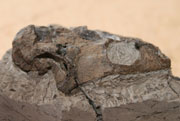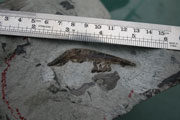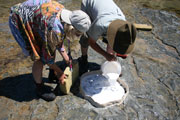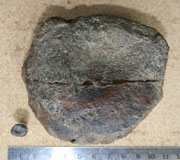| Monash home | About Monash | Faculties | Campuses | Contact Monash |
| Staff directory | A-Z index | Site map |
| Monash home | About Monash | Faculties | Campuses | Contact Monash |
| Staff directory | A-Z index | Site map |
|
DINOSAUR DREAMING 2008 updateThe 16th annual Dinosaur Dreaming field season gets under way on the 2nd February 2009. The dig will again concentrate on the main excavations at the Flat Rocks site, continuing on from where we left off last summer. Unlike previous years, this field season will only last for four weeks (instead of the usual six). Our last excavating day will take place on the 26th February. Anyone wishing to visit the site during the field season should check out the low tide times as we only have access to the fossil layer 3-4 hours either side of low tide. The closest car park is at “The Caves”, approximately 5kms outside Inverloch along the Cape Paterson Road. More information about the dig can be found at the Inverloch Environment Centre or any of the Bass Coast Information Centres. Don’t forget to check out our blog site during the field season Preparation and research into the fossil bones and teeth found during the Dinosaur Dreaming 2008 field season has produced some interesting results: More than 700 fossils were catalogued during the six week dig at Inverloch, including three more mammal jaws. Two of the jaws belong to the monotreme group Teinolophos. One in particular is very interesting as it contains features that are not present on the other Teinolophos specimens. Dr. Tom Rich is currently researching this specimen.  New monotreme mammal jaw This year was our 15th consecutive annual field season at the Flat Rocks site near Inverloch. In the last fifteen years we have found hundreds of turtle bones and shell fragments, but never a complete skull – until this year. One of the many bones that was recovered this year was badly damaged during extraction and it wasn’t until it was being prepared that it became clear as to what it was – a turtle skull with no reduction in the back of the skull as you see in modern turtles. This specimen is going to be very important in linking all the turtle skull fragments we have found in the past.  Turtle skull Some very nice ornithopod (small, plant-eating dinosaurs) bones were found this year also, including two tibiae and a femur. We also recovered the most complete ornithopod maxilla (upper jaw) to be found in the Strzelecki Group. It contains four erupted teeth and five unerupted teeth, as well as possibly part of the jugal. Preparation of this specimen is taking place at Museum Victoria.  ornithopod tibia  ornithopod upper jaw During the dig we made a mould of the large theropod dinosaur footprint that was found last field season by Tyler Lamb. We had to wait for a day when the tide was very low and the weather was fine so we had plenty of time to pour the silicone rubber. The mould has been taken back to the Museum where casts can be made. It was decided that the rock in which the footprint occurs is too cracked and friable to try and remove the footprint without damaging it.  pouring mould of theropod dinosaur footprint The six week dig is not the only work carried out by the Dinosaur Dreaming project. Throughout the year a dedicated group of volunteers prospect the south coast of Victoria looking for newly exposed fossils. Mike Cleeland, a geologist from Phillip Island, usually leads the prospecting trips and has an eagle eye for spotting fossils in the rock. This year he and his group have found some very interesting specimens along the Bass Coast between San Remo and Inverloch, including the largest and smallest vertebrae of an extinct group of amphibians that looked like giant salamanders (Koolasuchus cleelandi).  small and large centra |
|